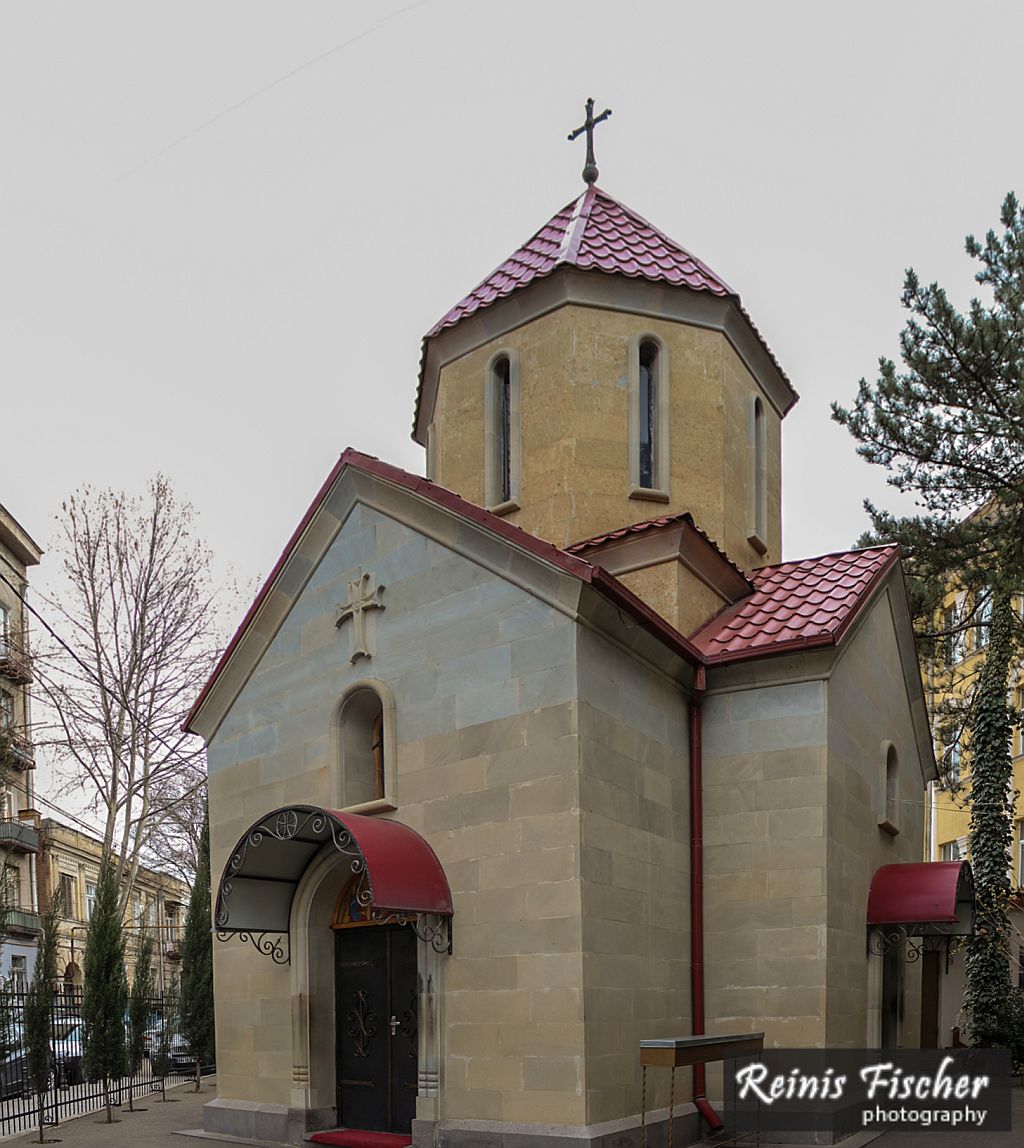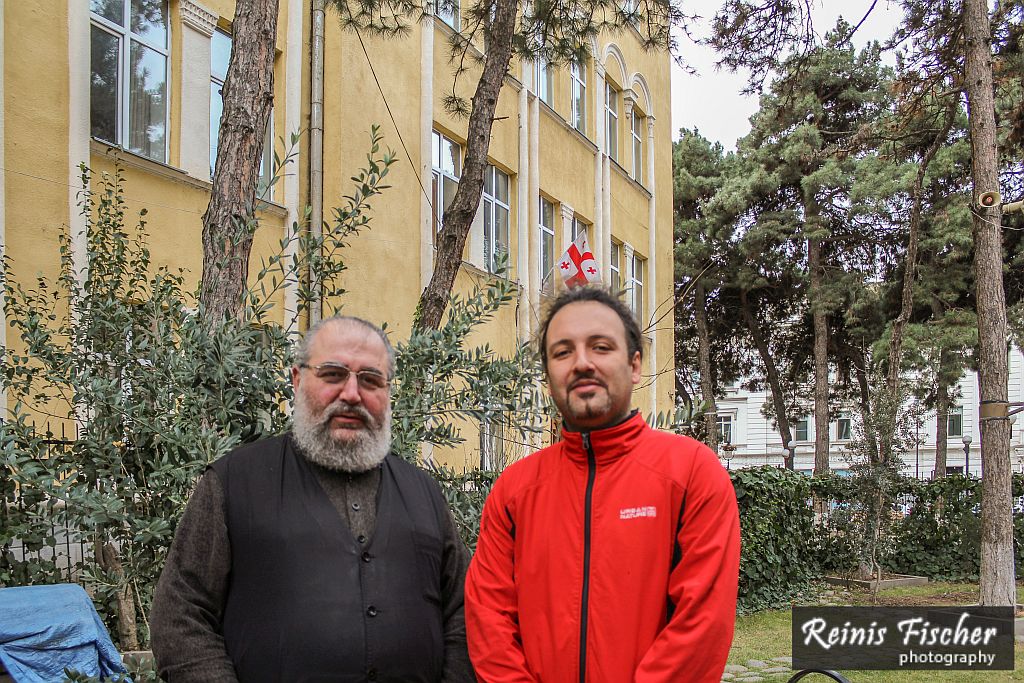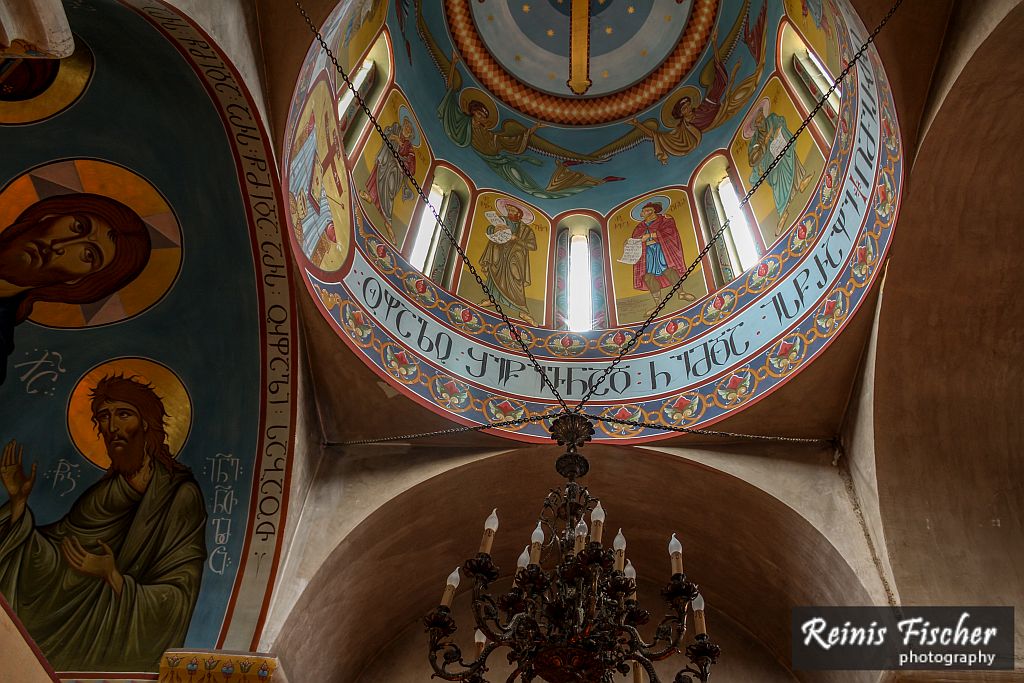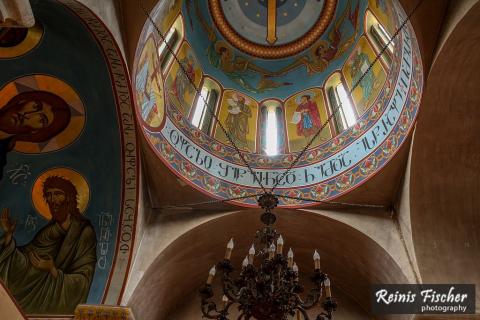There is a small church located on Baku street 1, Tbilisi (on the right side from David Aghanashebeli avenue, first cross-street before Tamar Mephe avenue). I have wondered about this church for the couple of the last 3 years, while been living in this neighborhood.
It was day 131/365 from my photo project, when I decided I'll go and photograph exactly this church and probably will learn more about it. So I went...

Saint Ekvtime Takaishvili Church in Tbilisi
I installed a tripod and started to play with panorama techniques (as I couldn't get this building in a horizontal frame), unfortunately weather was not my best friend today and in final image, the skies are totally blown up.
Next I decided to try my luck inside, using some interior photography techniques, so I entered the church and asked the lady (a nun?), who were sitting right next to the entrance - can I photography here? At start she told me, that it's not allowed, but I could try to ask for permission to priest, the lady took me to some other building (outside the church), and I was knocking to the priest door. Priest answered - Modi! (Come in!). I opened doors and asked to the priest, could I take some photos of this church. Priest gave me his allowance and started a brief conversation with me, after which I asked could I make a photo of him.

From the left: Father Nikolay of Ekvtime Takaishvili church; author of this blog in red
It was just matter of technique to set camera on timer. We had a small talk with Father Nikolay. I asked what's the name of this church actually. Father told me a brief story about Ekvtime Takaishvili, and that actually this church in named after him.
Ekvtime Takaishvili (1863-1953) was a Georgian historian, archeologist and public benefactor.
Born in the village of Likhauri in the western Georgian province of Guria (then part of Imperial Russia) to a local nobleman Svimon Takaishvili, he graduated from St. Petersburg University in 1887. From 1887 to 1917, he lectured on the history of Georgia at various prestigious schools in Tbilisi, including the Tbilisi Gymnasium for Nobility. During these years, he was actively involved in extensive scholarly activities and chaired, from 1907 to 1921, the Society of History and Ethnography of Georgia. Between 1907 and 1910, he organized a series of archeological expeditions to the historic Georgian region of Tao-Klarjeti (now part of Turkey).
After the February Revolution, he engaged also in politics, taking part in the establishment of the National Democratic Party of Georgia in 1917 and being elected to a post of Deputy Chairman in the Constituent Assembly of the Democratic Republic of Georgia from 1919 to 1921.
In 1917, he was among the founders and professors of the Tbilisi State University (TSU). He lost his tenure both in the parliament and at the TSU in 1921, when the Bolshevik Russia's 11th Red Army put an end to Georgia's independence. He followed the Georgian government in their French exile, taking the Georgian national treasury – numerous precious pieces of Georgian material culture - with him to Europe.
The treasury contained into 39 immense boxes, were shipped to Marseille and placed in a bank depository. Subsequently this precious cargo was transferred to one of the banks in Paris. Although the treasury was officially the property of the Georgian government-in-exile, it was actually Ekvtime Takaishvili who supervised this huge collection. In the early 1930s, Takaishvili won a lawsuit against Salome Obolenskaya (1878-1961), daughter of the last Mingrelian prince Nikoloz Dadiani, who also laid claim to a part of the treasury taken from the former Dadiani Palace in Zugdidi, Georgia. Despite numerous attempts by various European museums to purchase portions of this treasury, and extreme economic hardship, Takaishvili never sold a single piece of the priceless collection to live on and guarded it until 1933, when the League of Nations recognized the Soviet Union; the Georgian embassy in Paris was abolished and transformed into the "Georgian Office". The treasury passed into the possession of the French state. In 1935, Takaishvili urged the French government to hand the collections to Georgia, but it was not until the end of the World War II when was he able, in November 1944, to attract the attention of the Soviet ambassador A. Bogomolov to the fate of the Georgian treasury. Joseph Stalin's good relations with General Charles de Gaulle enabled Takaishvili to bring the treasury back to Georgia. However, Takaishvili had to spend his long unhappy days in Tbilisi under house arrest, seemingly considered to be too old to be imprisoned.
He was an author of numerous scholarly works on the history and archeology of Georgia and the Caucasus which are of special value even today. In Tbilisi, Tbilisi Second Gymnasium has been named after him. He has been canonized by the Georgian Orthodox Church. In 2013, he was posthumously awarded the title and Order of National Hero of Georgia.

Inside Saint Ekvtime Takaishvili church in Tbilisi

Prayer candles at Saint Ekvtime Takaishvili church in Tbilisi
At the end above picture made as my day 131 photography

Cupola
